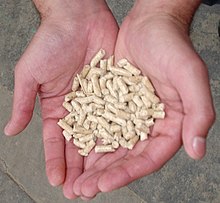Our website is made possible by displaying online advertisements to our visitors.
Please consider supporting us by disabling your ad blocker.
Pellet fuel

Pellet fuels (or pellets) are a type of solid fuel made from compressed organic material.[1] Pellets can be made from any one of five general categories of biomass: industrial waste and co-products, food waste, agricultural residues, energy crops, and untreated lumber.[2] Wood pellets are the most common type of pellet fuel and are generally made from compacted sawdust[3] and related industrial wastes from the milling of lumber, manufacture of wood products and furniture, and construction.[4] Other industrial waste sources include empty fruit bunches, palm kernel shells, coconut shells, and tree tops and branches discarded during logging operations.[5][6] So-called "black pellets" are made of biomass, refined to resemble hard coal and were developed to be used in existing coal-fired power plants.[7] Pellets are categorized by their heating value, moisture and ash content, and dimensions. They can be used as fuels for power generation, commercial or residential heating, and cooking.[8]
Pellets are extremely dense and can be produced with a low moisture content, below 10%, that allows them to be burned with a very high combustion efficiency.[9] Their regular geometry and small size allow automatic feeding with very fine calibration. They can be fed to a burner by auger feeding or by pneumatic conveying. Their high density permits compact storage and transport over long distance. They can be conveniently blown from a tanker to a storage bunker or silo on a customer's premises.[10]
A broad range of pellet stoves, central heating furnaces, and other heating appliances have been developed and marketed since the mid-1980s.[11] With the surge in the price of fossil fuels since 2005, the demand for pellet heating has increased in Europe and North America, and a sizable industry is emerging. According to the International Energy Agency Task 40, wood pellet production more than doubled between 2006 and 2010 to over 14 million tons.[12] In a 2012 report, the Biomass Energy Resource Center says that it expects wood pellet production in North America to double again in the next five years.[13]
| Fuels for heating |
- ^ "Biomass Energy". Alternate Energy. Retrieved 16 February 2015.
- ^ "Sources of biomass". BIOMASS Energy Centre. Archived from the original on 11 June 2016. Retrieved 16 February 2015.
- ^ "Organic Energy Ltd". Organicenergy.co.uk. Archived from the original on 3 January 2017. Retrieved 25 November 2015.
- ^ "About the Densified Biomass Fuel Report". U.S. EIA. October 17, 2018. Retrieved October 23, 2018.
- ^ "Use EFB Pellet as Renewable Energy". Biofuel Resource. 18 December 2012. Retrieved 16 February 2015.
- ^ Wood Pellets from PKS & Coconut Shell. "Wood Pellets from PKS and Coconut Shell". Retrieved 13 January 2013.
- ^ "Pretty weird and awfully clever". News from Vattenfall. Retrieved 1 June 2015.
- ^ Alakangas, Eija (18 November 2009). "European pellet standards". Archived from the original on 8 October 2016. Retrieved 16 February 2015.
- ^ Cite error: The named reference
Manometwas invoked but never defined (see the help page). - ^ "Wood Pellet Central-Heating Solution for Homeowners and Small Industry". MY WOOD PELLET SOLUTION. Archived from the original on 23 January 2012. Retrieved 30 December 2011.
- ^ "Biography of Dr. Jerry Whitfield". 27 March 2014. Retrieved 16 February 2015.
- ^ Cocchi, Maurizio (December 2011). "Global Wood Pellet Industry Market and Trade Study" (PDF). IEA Task 40. Archived from the original (PDF) on 25 April 2012. Retrieved 1 June 2012.
- ^ Frederick, Paul. "2012 VT Wood Chip & Pellet Heating Conference" (PDF). Biomass Energy Resource Center. Retrieved 23 January 2012.
Previous Page Next Page


